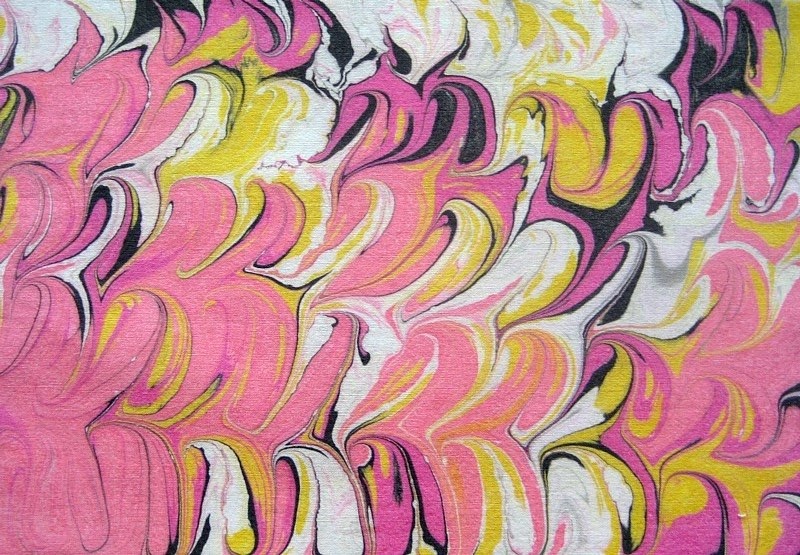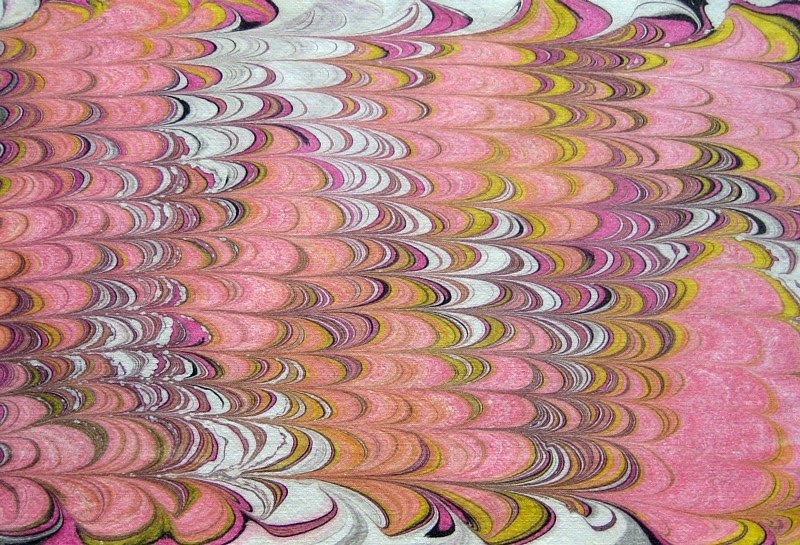Some of you may know that I've spent a lot of time trying to crack the code of fabric marbling. To be honest, the whole process has at times felt like two steps forward, one step back. But I feel I've gained a lot of insights into this art form, and I'm now ready to both write about it and teach it.
If you want to know about the process read on. If you're more interested in images of the result, scroll down. ;-)
I've written about marbling once before,
here, when I first tried marbling with wallpaper paste as the base, or size as it's called. The results were quite pleasing, but not what I had expected, as the paints didn't behave the way I wanted them to. In traditional marbling, the paints float out on the surface of the size and you can build patterns with circles within circles. Not so with the wallpaper paste.
About a month ago I started experimenting again with the technique, and with different mediums. In many instructions
carrageenan (a seaweed derivative also used in the food industry) is recommended for the size, but since that is difficult to find in Finland, I decided to try wallpaper paste again, as well as a size made from potato flour. I had mixed success.
The problem I had with wallpaper paste is that it was very difficult to get the right consistency. If it was thin the paints sank, and if it was thick the paints just sat on the surface like scared little rabbits. A common advice is to thin the paint if it sinks, but I found that with wallpaper paste it didn't make much difference. In fact, the paint seemed to sink even faster when I thinned it. And the point is: you can't thin paint
in absurdum, because you'll just get weak paint - weak colour and weak bonding to the fabric. My conclusion,
for now, as for wallpaper paste, is that it works well if it's thick enough to carry the paint (I used 10 g of Kiilto Wall Eco glue powder to 5 dl water, but different brands may vary so you will have to experiment), and if you don't mind that the paint sits on the surface instead of spreading out. You'll just have to work the paint a little more to get patterns, and the patterns will be a little different from the ones you get in traditional marbling. Please refer to my
earlier blog entry for images.
A size made from potato flour (I mixed a small amount of potato flour (1 tbs) in water (5 dl) and heated it to simmering point to thicken the mix) worked better than wallpaper paste. In fact, the paints spread exactly the way I wanted them to. The problem, however, is that a size made from potato flour can be quite uneven, the consistency changes with time and a skin forms. Also, if you don't get the right consistency straight away, there's not much you can do about it. You'll just have to cook a new mix and wait for the size to cool. My conclusion is that a size from potato flour and water works for traditional marbling, but it is unpredictable and difficult to adjust. I'm not sure I'll bother with it again... Especially since...
... I was on the brink of giving up when I found - drum roll -
Deka Marble Medium.
Deka Marble Medium (which I suspect might be carrageenan, but it doesn't say so) does what it is supposed to do. It is easy to mix, and it holds the paints. If it's too thick you can add some water to it, and if it's too thin, you can thicken it with more medium. The consistency is crucial, and it may vary with different paints, so don't be discouraged if the paints sink at first. Here's some advice:
The first time I tried the medium, I weighed the powder (10 g to 2 L of water) and it worked like a charm. The second time I measured the powder with a teaspoon according to the instructions (2 tsp to 2 L of water). That didn't work at all. The paint which worked so well before sank like a rock no matter how much I thinned it. So the third time I measured the spoons with the help of my scales and discovered that 2 tsp was less than 8 g. So the right amount is more like 2.5 tsp to 2 L.
Another interesting thing I discovered was that if the Deka Marble Medium is too thick, the paints might also sink. The third time I made the size a little bit thicker (11 g powder to 2 L) for the sake of the experiment, and to my astonishment, the paint which had worked fine before sank. I then added 0.5 dl of water to the size and the paint was fine again. So, the lesson learned is that marbling is an art form that you don't learn in one sitting, but with a bit of patience and understanding (i.e. experience) of the medium and paints, you will succeed. In my next blog entry I'll write about paints. Here are some images of my work space and favourite samples:
Work in progress
Drying area
Favourite samples
Thanks for visiting my blog! More to follow soon!
- Annika













